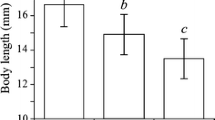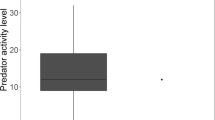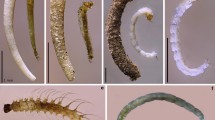Abstract
The aquatic larvae of two species of salamanders coexist as a result of differences in their competitive abilities: Ambystoma talpoideum is a superior aggressor, whereas A. maculatum is a superior forager. I examined the behavioral mechanisms that permit these species to coexist with their predatory congener, A. opacum. I asked whether the two prey species differ in their vulnerability to predation and in their use of structural and spatial refugia when under the risk of predation; such inter-specific variation may allow predation to contribute indirectly to prey coexistence. Larval A. maculatum (the superior forager) was more vulnerable to predation by A. opacum than was A. talpoideum, and only the latter species significantly increased its use of structural refugia (leaf litter) in the presence of the predator. In pond enclosures, both species of prey exhibited diel patterns of microhabitat use; significantly more larvae occupied shallow regions of enclosures during the day and migrated to deeper water (a spatial refugium) at night. However, when considered separately, neither (1) the presence of a predatory larval A. opacum nor (2) an increased density of intra- and interspecific competitors significantly altered this habitat shift for either prey species. Rather, diel microhabitat usage in A. talpoideum was significantly affected by an interaction between predator presence and competitor density. My results demonstrate the importance of refugia to coexistence in this predator-prey assemblage. Furthermore, predation by A. opacum may mediate prey competition; that is, preferential consumption of A. maculatum may reduce the competitive impact of this superior forager on A. talpoideum, thus enhancing their coexistence.
Similar content being viewed by others
References
Branch LC, Altig R (1981) Nocturnal stratification of three species of Ambystoma larvae. Copeia 1981:870–873
Brodie ED Jr (1983) Antipredator adaptations of salamanders: evolution and convergence among terrestrial species. In: Margaris NS, Arianoutsou-Faraggitaki M, Reiter RJ (eds) Plant animal, and microbial adaptation to terrestrial environment. Plenum, New York, pp 109–133
Brodie ED Jr, Formanowicz DR Jr, Brodie ED III (1991) Predator avoidance and antipredator mechanisms: distinct pathways to survival. Ethol Ecol Evol 3:73–77
Brodman RD (1992) The interactions of coexisting guild members: competition and predation in two species of Ambystoma larvae. Ph.D. thesis, Kent State University, Kent, Ohio
Brown JH, Heske EJ (1990) Control of a desert-grassland transition by a keystone rodent guild. Science 250:1705–1707
Buchanan BW (1993) Effects of enhanced lighting on the behaviour of nocturnal frogs. Anim Behav 45:893–899
Christensen B, Persson L (1993) Species-specific antipredatory behaviours: effects on prey choice in different habitats. Behav Ecol Sociobiol 32:1–9
Conant R, Collins JT (1991) A field guide to reptiles and amphibians: eastern and central North America. Houghton Mifflin, Boston
Cooper SD, Walde SJ, Peckarsky BL (1990) Prey exchange rates and the impact of predators on prey populations in streams. Ecology 71:1503–1514
Cortwright SA (1988) Intraguild predation and competition: an analysis of net growth shifts in larval amphibian prey. Can J Zool 66:1813–1821
Cortwright SA, Nelson CE (1990) An examination of multiple factors affecting community structure in an aquatic amphibian community. Oecologia 83:123–131
Fecner DH Jr (1981) Competition between and species: outcome controlled by parasitic flies. Science 214:815–817
Fraser DF, Gilliam JF (1992) Nonlethal impacts of predator invasion: facultative supression of growth and fecundity. Ecology 73:959–970
Garvey JE, Stein RA, Thomas HM (1994) Assessing how fish predation and interspecific prey competition influence a crayfish assemblage. Ecology 75:532–547
Gause G (1934) The struggle for existence. Williams and Wilkins, Baltimore
Gilliam JF, Fraser DF (1988) Resource depletion and habitat segregation by competitors under predation hazard. In: Ebenman B, Persson L (eds) Size-structured populations: ecology and evolution. Springer, Berlin Heidelberg New York, pp 173–184
Hardy LM, Raymond LR (1980) The breeding migration of the mole salamander, Ambystoma talpoideum, in Louisiana. J Herpetol 14:327–335
Hixon MA, Menge BA (1991) Species diversity: prey refuges modify the interactive effects of predation and competition. Theor Pop Biol 39:178–200
Holomuzki JR (1986a) Predator avoidance and diel patterns of microhabitat use by larval tiger salamanders. Ecology 67:737–748
Holomuzki JR (1986b) Effect of microhabitat use on fitness components of larvae of tiger salamanders, Ambystoma tigrinum nebulosum. Oecologia 71:142–148
Holt RD (1987) Prey communities in patchy environment. Oikos 50:276–290
Huffaker CB (1958) Experimental studies on predation: dispersion factors and predator-prey oscillations. Hilgardia 27:343–383
Kohler SL, McPeek MA (1989) Predation risk and the foraging, behavior of competing stream insects. Ecology 70:1811–1825
Kotler BP (1984) Risk of predation and the structure of desert rodent communities. Ecology 65:689–701
Kotler BP, Brown JS (1988) Environmental heterogeneity and the coexistence of desert rodents. Annu Rev Ecol Syst 19:281–307
Kotler BP, Brown JS, Hasson O (1991) Factors affecting gerbil foraging behavior and rates of owl predation. Ecology 72:2249–2260
Kotler BP, Holt RD (1989) Predation and competition: the interaction of two types of species interactions. Oikos 54:256–260
Lampert W (1987) Vertical migration of freshwater zooplankton: indirect effects of vertebrate predators on algal communities. In: Kerfoot WC, Sih A (eds) Predation: direct and indirect impacts on aquatic communities. University Press of New England, Hanover, pp 291–299
Lawler SP (1989) Behavioural responses to predators and predation risk in four species of larval anurans. Anim Behav 38:1039–1047
Lima SL, Dill LM (1990) Behavioral decisions made under the risk of predation: a review and prospectus. Can J Zool 68:619–640
Lubchenco J (1986) Relative importance of competition and predation: early colonization by seaweeds in New England. In: Diamond J, Case TJ (eds) Community ecology. Harper and Row, New York, pp 537–555
Morin PJ (1981) Predatory salamanders reverse the outcome of competition among three species of anuran tadpoles. Science 212:1284–1286
Morin PJ (1987) Salamander predation, prey facilitation, and seasonal succession in microcrustacean communities. In: Kerfoot WC, Sih A (eds) Predation: direct and indirect impacts on aquatic communities. University Press of New England, Hanover, pp 174–187
Murdoch WW, Oaten A (1975)_ Predation and population stability. Adv Ecol Res 9:2–132
Paine RT (1966) Food web complexity and species diversity. Am Nat 100:65–75
Peckarsky BL, Cowan CA, Penton MA, Anderson C (1993) Sublethal consequences of stream-dwelling predatory stoneflies on mayfly growth and fecundity. Ecology 74:1836–1846
Persson L (1991) Behavioral response to predators reverses the outcome of competition between prey species. Behav Ecol Sociobiol 28:101–105
Persson L (1993) Predator-mediated competition in prey refuges: the importance of habitat dependent prey resources. Oikos 68:12–22
Pierce CL (1988) Predator avoidance, microhabitat shift, and risksensitive foraging in larval dragonflies. Oecologia 77:81–90
Power ME (1984) Depth distribution in armored catfish: predator-induced resource avoidance? Ecology 65:523–528
SAS Institute (1990) SAS user's guide: statistics, version 6 edn. SAS Institute, Cary
Semlitsch RD (1987) Interactions between fish and salamander larvae: costs of predator avoidance or competition? Oecologia 72:481–486
Semlitsch RD (1988) Allotopic distribution of two salamanders: effects of fish predation and competitive interactions. Copeia 1988:290–298
Semlitsch RD, Wall SC (1993) Competition in two species of larval salamanders: a test of geographic variation in competitive ability. Copeia 1993:587–595
Siegel S (1956) Nonparametric statistics for the behavioral sciences. McGraw-Hill, New York
Sih A (1987) Predators and prey lifestyles: an evolutionary and ecological overview. In: Kerfoot WC, Sih A (eds) Predation: direct and indirect impacts on aquatic communities. University of New England Press, Hanover, pp 203–224
Sih A, Kats LB (1991) Effects of refuge availability on the responses of salamander larvae to chemical cues from predatory green sunfish. Anim Behav 42:330–332
Sih A, Petranka JW, Kats LB (1988) The dynamics of prey refuge use: a model and tests with sunfish and salamander larvae. Am Nat 132:463–483
Skelly DK (1992) Field evidence for a cost of behavioral antipredator response in a larval amphibian. Ecology 73:704–708
Skelly DK, Werner EE (1990) Behavioral and life-historical responses of larval American toads to an odonate predator. Ecology 71:2313–2322
Snedecor GW, Cochran WG (1980) Statistical methods. Iowa State University Press, Ames
Sredl MJ, Collins JP (1992) The interactions of predation, competition, and habitat complexity in structuring and amphibian community. Copeia 1992:607–614
Stangel PW, Semlitsch RD (1987) Experimental analysis of predation on the diel vertical migrations of a larval salamander Can J Zool 65:1554–1558
Stenhouse SL (1985) Interdemic variation in predation on salamander larvae. Ecology 66:1706–1717
Stenhouse SL, Hairston NG, Cobey AE (1983) Predation and competition in Ambystoma larvae: field and laboratory experiments. J Herpetol 17:210–220
Stenson JAE (1978) Differential predation by fish on two species of Chaoborus (Diptera, Chaoboridae). Oikos 31:98–101
Stewart MM (1956) The separate effects of food and temperature differences on development of marbled salamander larvae. J Elisha Mitchell Sci Soc 72:47–56
Walls SC (1991) Mechanisms of coexistence in a guild of ambystomatid salamanders: the importance of stage-dependent regulation in species with a complex life cycle Ph.D. thesis, University of Southwestern Louisiana, Lafayette
Walls SC, Jaeger RG (1987) Aggression and exploitation as mechanisms of competition in larval salamanders. Can J Zool 65:2938–2944
Walls SC, Jaeger RG (1989) Growth in larval salamanders is not inhibited through chemical interference competition. Copeia 1989:1049–1052
Werner EE (1991) Nonlethal effects of a predator on competitive interactions between two anuran larvae. Ecology 72:1709–1720
Werner EE (1992) Individual behavior and higher-order species interactions. Am Nat 140:S5-S32
Werner EE, Anholt BR (1993) Ecological consequences of the trade-off between growth and mortality rates mediated by foraging activity. Am Nat 142:242–272
Wilbur HM (1972) Competition, predation, and the structure of the Ambystoma-Rana sylvatica community. Ecology 53:3–21
Wilbur HM (1976) Density-dependent aspects of metamorphosis in Ambystoma and Rana sylvatica. Ecology 57:1289–1296
Wilbur HM (1988) Interactions between growing predators and growing prey. In: Ebenman B, Persson L (eds) Size-structured populations: ecology and evolution. Springer, Berlin Heidelberg New York, pp 157–172
Wilbur HM, Morin PJ, Harris RN (1983) Salamander predation and the structure of experimental communities: anuran responses. Ecology 64:1423–1429
Zar JH (1984) Biostatistical analysis. Prentice-Hall, Englewood Cliffs
Author information
Authors and Affiliations
Rights and permissions
About this article
Cite this article
Walls, S.C. Differential vulnerability to predation and refuge use in competing larval salamanders. Oecologia 101, 86–93 (1995). https://doi.org/10.1007/BF00328904
Received:
Accepted:
Issue Date:
DOI: https://doi.org/10.1007/BF00328904




